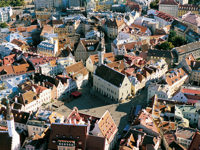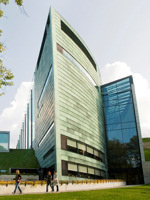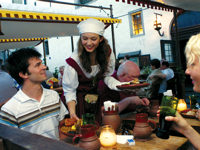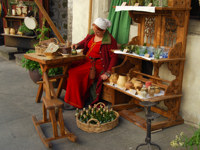Explore Tallinn: European Capital of Culture
As Tallinn enjoys its year in the spotlight as a 2011 European Capital of Culture, visitors continue to be charmed by its chocolate box Old Town, a UNESCO World Heritage site.
Travellers to Tallinn can enjoy some of the best accommodation deals in Europe after a hotel building boom preceded the current recession, leaving the Estonian capital with a surplus of hotel rooms and plummeting prices.
Tallinn: European Capital of Culture 2011
‘Stories of the Seashore’ is the theme during Tallinn’s European Capital of Culture year, part of the city’s wider effort to reopen the waterfront to the public after years as a ‘no go’ zone under Soviet occupation.
Highlights include: Estonian Music Days (21-27 March), featuring new works by Estonian composers inspired by the city; the Estonian Youth Song and Dance Celebrations (1-3 July), performances by 35,000 young artistes; and The Battle of EST (2-3 December) a street dance festival with 300 entertainers from 20 countries.
Tallinn: Old Town
 Wander through Tallinn's narrow streets and charming courtyards.
Wander through Tallinn's narrow streets and charming courtyards.Tallinn City Tourist Office and Convention Bureau/Toomas Volmer
Tallinn’s compact Old Town is crisscrossed with cobbled streets and narrow alleys, which converge in charming courtyards. Few places in Europe capture the aura of the Middle Ages as enchantingly as Tallinn.
The majestic Town Hall, dating from 1404, is the best preserved medieval town hall in northern Europe. Nearby, the 12th-century St Olav’s Church was once the tallest building in the world and was used by the KGB as a radio tower. Climb the stairs for some of the best views of Tallinn from the observation deck.
About half of Tallinn’s original red-coned watchtowers, part of the city wall, are still standing. You can walk along the top of the wall or peer into its fortifications at Kiek in de Kök - ‘peep into the kitchen’ in Low German (so called because soldiers could peer into residents’ houses from the tower). Here, a ‘time train’ through underground passages takes visitors back to 1219, accompanied by a multimedia video and sound show.
A couple of streets lead to Toompea Hill, the former residential area of the nobility, topped by a baroque castle complex and the magnificent, domed Alexander Nevsky Cathedral. This is where you’ll find sweeping vistas of Tallinn’s Old Town and bay from the Kohtu Street and Patkul viewing platforms.
Tallinn: Art
 Explore Tallinn's KUMU Art Museum.
Explore Tallinn's KUMU Art Museum.Tallinn City Tourist Office and Convention Bureau/Karel Koplimets
A few tram stops from the centre on a hill overlooking Kadriorg Park is Kumu (pronounced ‘koomoo’ and short for kunstimuuseum which means Art Museum). The largest of its kind in the Baltic region, the museum makes essential viewing as an overview of Estonian art from the 18th century to the present day. The striking building was named European Museum of the Year in 2008.
Nearby, the Kadriorg Palace Art Museum houses 16th-18th-century Dutch, Italian, Russian and German masters. The palace was built by Peter the Great for his Estonian wife, Catherine.
The Old Town includes Haus Gallery, a leader in educating the nascent Estonian art-buying public; The Draakoni Gallery, named for the giant dragons on the outstanding art deco building; and its sister gallery, the Hobusepea (Horse’s Head) Gallery, which presents video works and installations.
Tallinn: Eating and drinking
 Sample traditional Estonian fare in one of Tallinn's many restaurants
Sample traditional Estonian fare in one of Tallinn's many restaurantsTallinn City Tourist Office and Convention Bureau/Andreas Meichsner
Traditional Estonian food is heavy on meat and carbs. Pork is ever-present, while some menus also feature more unusual items, such as moose or wild boar. As with most European cities, there is also a fair selection of international cuisine on offer. Vegetarian eateries are unheard of, although most Tallinn restaurants have meat-free options.
In the Old Town, the country-style Kuldse Notsu Kõrts (Golden Piglet Inn) serves traditional favourites, as does Eesti Maja (Estonian House), located in the business district just south of the Old Town.
Just off Old Town Square, Olde Hansa offers a glimpse into medieval fare in a rich merchant’s household. Diners sit at trestle tables, served by costumed staff bearing large platters of food and flagons of beer and wine, while being serenaded by strolling minstrels.
Similarly, the cavernous, timber-beamed Peppersack has a sumptuous menu. Here, you might be treated to an Errol Flynn-style sword fight while you work your way through the chicken skewers, lamb shanks or marinated herring.
For Old Town pubs, try Karja Kelder, a cellar bar that claims to be the oldest in Tallinn, or Valli Baar, where the crowd bustles around a rectangular central bar. Otherwise, ex-pats seem to rule the roost in Old Town bar-keeping. Check out Nimeta Baar (The Bar With No Name), a lively sports bar founded by some Scots who visited for a football match and didn’t return.
Tallinn: Shopping
Tallinn’s Old Town teems with souvenir shops of varying quality and questionable prices. One reliable stop-off is St Catherine’s Passage, home to a crafts guild and a collection of shops where you can watch craftspeople at work and purchase their wares. For a genuine, one-off item, head for A-Gallery on Hobusepea Street, an artist-owned cooperative specialising in contemporary Estonian jewellery.
 See traditional crafspeople at work in St Catherine’s Passage
See traditional crafspeople at work in St Catherine’s PassageTallinn City Tourist Office and Convention Bureau/Mari Kadanik
Just outside the Old Town are three retail meccas. On either side of the leafy central square are Viru Keskus, a modern shopping centre, and Solaris Centre, the city’s newest shopping and entertainment complex (the largest in the Baltic region). Nearby is the Finnish-owned chain department store, Stockmann.
Tallinn: Hotels
There is a wide choice of hotels in Tallinn to choose from. In the shadow of Toompea Hill and a pleasant walk from the Old Town, the Meriton Grand Conference and Spa Hotel is one of Tallinn’s most recent additions, complete with the city’s biggest hotel gym.
Across from one of the Old Town gates, is the Sokos Hotel Viru which opened in 1972 as part of Intourist, the official Russian state travel agency. After the collapse of the Soviet Union, the new owners found plans indicating the existence of a previously unknown, 23rd floor. This turned out to be home to a KGB radio room where coded messages were picked up from Soviet embassies in the Nordic countries and relayed to Moscow. From 13 January, the secret room will become a KGB-themed museum.
For an Old Town option on a smaller scale, the elegant Hotel Telegraaf is located in the 19th-century home of the Estonian Telegraph Company. A favourite with visiting celebrities and politicians, it oozes fin de siècle elegance.
Most large hotels in Tallinn have extensive spa facilities, public bathing being a traditional Nordic obsession.
Insider tip:
The terrace of the 24th-floor Lounge 24 in the Radisson Blu Hotel Tallinn, offers spectacular panoramic city and harbour views of Tallinn. It is also the highest location in the city with outdoor seating.
Do you have any Feedback about this page?
© 2025 Columbus Travel Media Ltd. All rights reserved. No part of this site may be reproduced without our written permission, click here for information on Columbus Content Solutions.









 You know where
You know where